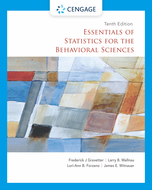Solution Found!
ANOVA: Text vs. Graphic Résumés Impact on Competence Ratings
Chapter 12, Problem 18(choose chapter or problem)
Open positions in the highest-paying jobs, the best internships, and the most prestigious graduate programs can attract many applicants. Initial evaluations of applications are usually based on the applicant’s résumé or curriculum vitae. In a recent study, researchers demonstrated that two different kinds of fancy “graphical résumés,” which include graphic descriptions of things like the timeline of an applicant’s education, are no more effective than traditional text-based résumés (Popham, Lee, Sublette, Kent, & Carswell, 2017). In many ways, they actually might be worse. Suppose that a researcher is interested in studying the effect of résumé type on participants’ ratings of the competence of the job applicant. She randomly assigns participants to one of three groups. Group 1 receives a traditional text-based résumé. Group 2 receives a graphic résumé with photos of the college that was listed under the applicant’s education. Group 3 receives a graphic résumé with charts summarizing the amount of time the hypothetical applicant spent at each of their previous jobs. All participants rate the perceived competence of the job applicant. The hypothetical data are listed below.
a. Use an ANOVA with \(\alpha=.05\) to determine whether there are any significant mean differences among the treatments.
b. Suppose that a researcher wanted to compare text résumés to graphic type 1 résumés only. What test statistic would the researcher use?
c. Write the results of the ANOVA as they would appear in a research article.
Questions & Answers
QUESTION:
Open positions in the highest-paying jobs, the best internships, and the most prestigious graduate programs can attract many applicants. Initial evaluations of applications are usually based on the applicant’s résumé or curriculum vitae. In a recent study, researchers demonstrated that two different kinds of fancy “graphical résumés,” which include graphic descriptions of things like the timeline of an applicant’s education, are no more effective than traditional text-based résumés (Popham, Lee, Sublette, Kent, & Carswell, 2017). In many ways, they actually might be worse. Suppose that a researcher is interested in studying the effect of résumé type on participants’ ratings of the competence of the job applicant. She randomly assigns participants to one of three groups. Group 1 receives a traditional text-based résumé. Group 2 receives a graphic résumé with photos of the college that was listed under the applicant’s education. Group 3 receives a graphic résumé with charts summarizing the amount of time the hypothetical applicant spent at each of their previous jobs. All participants rate the perceived competence of the job applicant. The hypothetical data are listed below.
a. Use an ANOVA with \(\alpha=.05\) to determine whether there are any significant mean differences among the treatments.
b. Suppose that a researcher wanted to compare text résumés to graphic type 1 résumés only. What test statistic would the researcher use?
c. Write the results of the ANOVA as they would appear in a research article.
ANSWER:Step 1 of 4
a. The raw data with the marginal totals are:
We have treatments and
replication per treatment and hence there are
observations.
Let be the competence of the
applicant in the
type of resume.
1. Calculate the correction factor:
